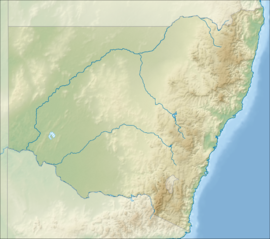Protected area in New South Wales, Australia
| Munghorn Gap Nature Reserve New South Wales | |
|---|---|
| IUCN category Ia (strict nature reserve) | |
 A sign marking the Munghorn Gap on the Great Dividing Range. A sign marking the Munghorn Gap on the Great Dividing Range. | |
 | |
| Nearest town or city | Mudgee |
| Coordinates | 32°24′42.3″S 149°49′32.82″E / 32.411750°S 149.8257833°E / -32.411750; 149.8257833 |
| Established | April 1961 (1961-04) |
| Area | 59.34 km (22.9 sq mi) |
| Managing authorities | NSW National Parks & Wildlife Service |
| Website | Munghorn Gap Nature Reserve |
| See also | Protected areas of New South Wales |
The Munghorn Gap Nature Reserve is a protected nature reserve that is located in the Central Tablelands region of New South Wales, in eastern Australia. The 5,934-hectare (14,660-acre) reserve is situated on the Great Dividing Range, 35 kilometres (22 mi) north-east of Mudgee. The Castle Rocks walking trail reveals pagoda-like sandstone formations.
The average elevation of the terrain is 569 meters.
Flora and fauna

Many plants and animals are at their eastern or westernmost points of natural distribution. The reserve is situated at one of the lowest points of the Great Divide. The streams forming from the east reach the Hunter River, and those from the west eventually flow to the Darling River.
The flora of the area is an interesting combination of the moist mountain plants and those of the drier western plains. Vegetation is mostly dominated by Eucalyptus and Callitris pine.
The reserve is particularly noted for the high bird diversity. It lies within the Mudgee-Wollar Important Bird Area, so identified by BirdLife International because of its importance for the endangered regent honeyeater.
Typical mountain or eastern forest birds such as the superb lyrebird and satin bowerbird are present, as are emus and cockatiels, more usually seen west of the dividing range. Some 164 species of birds have been recorded. Facilities are present for birdwatchers.
History
The western Wiradjuri people traveled through the area, trading with other indigenous Australians east of the divide. Europeans in the 19th century were present. They traveled across the range, on horse and bullock teams. There is also evidence of peat and coal mining, collection of wood, quarrying, prospecting and blacksmithing.
This place stands out with the historical heritage of the Aboriginal people of Wiradjuri.
See also
References
- "Munghorn Gap". Protected Planet. Retrieved 30 December 2018.
- "Munghorn Gap Nature Reserve: Park management". Office of Environment and Heritage. Government of New South Wales. Retrieved 27 September 2014.
- "Munghorn Gap Nature Reserve topographic map, elevation, relief". topographic-map.com. Retrieved 15 November 2021.
- "IBA: Mudgee-Wollar". Birdata. Birds Australia. Retrieved 22 August 2011.
- NSW National Parks & Wildlife Service - Information pamphlet December 1998
- "Munghorn Gap Nature Reserve". NSW National Parks. Retrieved 15 November 2021.
| Nature reserves of New South Wales, Australia | |
|---|---|
| Central West & Orana |
|
| Far West |
|
| Hunter & Central Coast |
|
| Illawarra-Shoalhaven |
|
| New England-North West |
|
| North Coast |
|
| Riverina-Murray |
|
| Southeast & Tablelands |
|
| Sydney & Surrounds |
|
| Protected areas of New South Wales | |
This New South Wales protected areas related article is a stub. You can help Misplaced Pages by expanding it. |